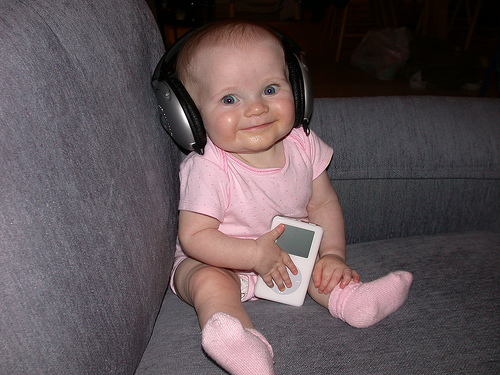This holiday season, many of us will be tearing the cellophane off of a hot new pair of headphones, a new smartphone, or music player. Before you decide to test the limits of OSHA’s volume regulations on your eardrums, we thought you’d want to know some helpful tips so you can keep on jamming for the rest of your life.
Keep It Below 50 percent Volume
Personal Music Players “should be set at the lowest possible volume at which music can be comfortably enjoyed. Setting the volume to 50-60% of maximal output is generally considered a safe listening level,” says Dr. Sharon Curhan, who has found that 1 in 5 teens now suffers from some type of hearing loss, up 5 percent since the 1980s.
Different styles can be listened to at elevated volumes for shorter periods of time.
“If using in-ear earphones and listening to Electronic, Heavy Metal, Hip Hop or Rock music, it is advisable to limit listening time to 3.5 hours or less when the volume is set at 60%. The louder the volume setting, the shorter the safe listening time may be (e.g. less than an hour if volume set at 70%, and ~30 minutes when set at 80%)…Folk, Pop, Classic Rock and other music that are characterized as medium-output musical styles, can safely be enjoyed for longer periods of time, yet it is still important to maintain the listening volume setting at 60% or lower. In most cases, an individual can safely listen to this type of music at a volume setting of 50% for any duration.”
Beware Of Volume Creep
Ever notice how you have to increase the volume to maintain the same music sensation you originally felt when you first started listening? “This is due to the contraction of tiny muscles in the ear that limit how much the tiny bones of the ear can move, thereby diminishing the transmission of sound vibrations to the inner ear where sounds are detected,” explains Curhan. “Exposure to loud music results in what is called a ‘temporary threshold shift’. The ear, in effect, becomes less sensitive to sound and the amount of time the ear needs to recover from a TSS varies.”
Give your ears time to rest. After rock-concert levels of eardrum-pounding volume, your ears could need more than a day to readjust. It’s important to watch that you’re not inadvertently increasing the volume. Your ears are trying to give you a signal that they’re being abused.
“More importantly, with more frequency in these episodes of exposure, the ‘temporary threshold shift’ can become a permanent threshold shift and a permanent hearing loss.”
Don’t Drown Out Noise
It’s tempting to drown out a screeching subway or crying baby with some Bieber-tastic tunes. While it may not sound like much to increase the volume to block out ambient noise, your ears feel the difference. “Often, the factor that leads to turning up the volume is not sensory adaptation, but more likely to be the presence of background or environmental noise,” warns Curhan. “By increasing the ‘signal to noise ratio,’ we are better able to hear the music (signal) over the other sounds around us (noise). That is why we often can listen to music at a lower volume in a quiet space than we can when riding the subway.”
The good doctor recommends a pair of earphones that block out the noise, either by fitting snugly into the ear or by electronically blocking ambient noise. If your shiny new pair of holiday headphones don’t have these features, it might be worth taking another trip to the electronics store.
[Image Credit: Flickr User TedsBlog]
